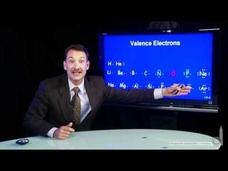Bozeman Science
Drawing Lewis Dot Diagrams
Mr. Andersen shows you how to draw Lewis Dot Diagrams for atoms and simple molecules.
Bozeman Science
Drawing Lewis Dot Diagrams
Viewers get a step-by-step explanation for drawing Lewis Dot Diagrams with a video that includes numerous examples of atoms, simple molecules, and how to represent covalent bonds.
GPB Television
Chemistry 502: The World of Atoms is Not Enough – Bonding Part II
"The name is Bond. James Bond." Or is that "Chemical Bond?" Assign the viewing of the video as homework, and then have your chemists come to class to practice drawing electron dot diagrams and Lewis structures with the several bonus...
Teacher's Pet
Bohr Model and Lewis Dot Structures
Don't let your pupils become bohred! Use the video lesson to describe the Bohr Model and the closely related Lewis Dot Structures. The video instructor describes the electron orbits and the importance of the valence electrons. She shows...
Fuse School
Electron Configuration of the First 20 Elements in the Periodic Table
Why is the periodic table arranged the way it is? As pupils complete the electron configuration of the first 20 elements, they see the relationship to the rows and columns in the periodic table. The video instructor highlights these...
Fuse School
What Are Dot and Cross Diagrams - Part 1
Throughout history, scientists used different methods for drawing elements, but most often the dot and cross diagrams appear. The video explains dot and cross diagrams, electrons, and electron shells. It highlights the importance of...
Fuse School
Energy Levels and Electron Configuration
Electron location accounts for many properties of an element. A video lesson describes how to create electron dot diagrams. The instructor discusses electron shells and the number of electrons in each.
Fuse School
What Are Dot and Cross Diagrams - Part 2
Electron dot diagrams seem simple, but does bonding complicate the notation? The video explains how to draw dot and cross diagrams when bonding exists. It describes both covalent and ionic bonding and the different ways of depicting...
Berkeley University of California
Covalent Bonding
You have a joke about covalent bonds? Do share! Discussing the difference in ionic and covalent bonding, the video focuses on electron sharing and molecular orbitals. Video is the third in a series of 15.
Berkeley University of California
Ionic Bonding
This instructional video explains how bonds are formed between different atoms. It discusses valence electrons, charges, electron transfer, and Coulomb attraction. It is the second in a 15-part series.
Berkeley University of California
Lewis Electron Dot Structures
You think all of the good periodic table jokes argon? I don't zinc so! Video discusses electron dot structures based on valence electrons. It highlights the arrangement of the periodic table and the stability of the noble gasses. This is...
Fuse School
Question - Matter Exam Question 1
How much does your class know about subatomic particles? Module 13 in a 14-part series tests their knowledge of how to determine an atom's number of protons, neutrons, and electrons when given the atomic number and the mass...
Fuse School
Question - Matter Exam Question 2
Looking for a great way to see what young chemists know about atomic structure? In the 14th and final installment in the states of matter series, learners put their skills to the test. The four-part question covers placement of...
Berkeley University of California
Sulfate Bond Order (NB)
Sharing is caring in covalent bonds. The instructor details how to solve for bond order in covalent bonds using electron dot structures to find the formal charges.
Berkeley University of California
Alcohol Oxidation (NB)
I blew up my chemistry experiment. Oxidants happen. The ninth video in the series walks through the steps on how to solve one problem by finding oxidation numbers using an electron dot structure.
Berkeley University of California
Formal Charge
Want to hear a joke about element 116? Uuh ... Here is a video that explains how to find the formal charge of a molecule using its covalent electron distribution. It focuses on electron dot structure and dividing the molecule into...















